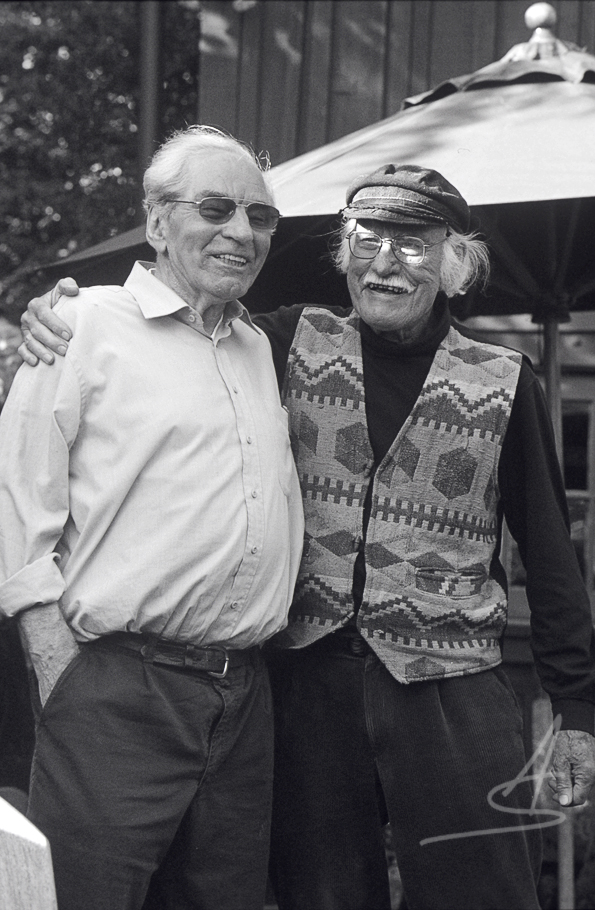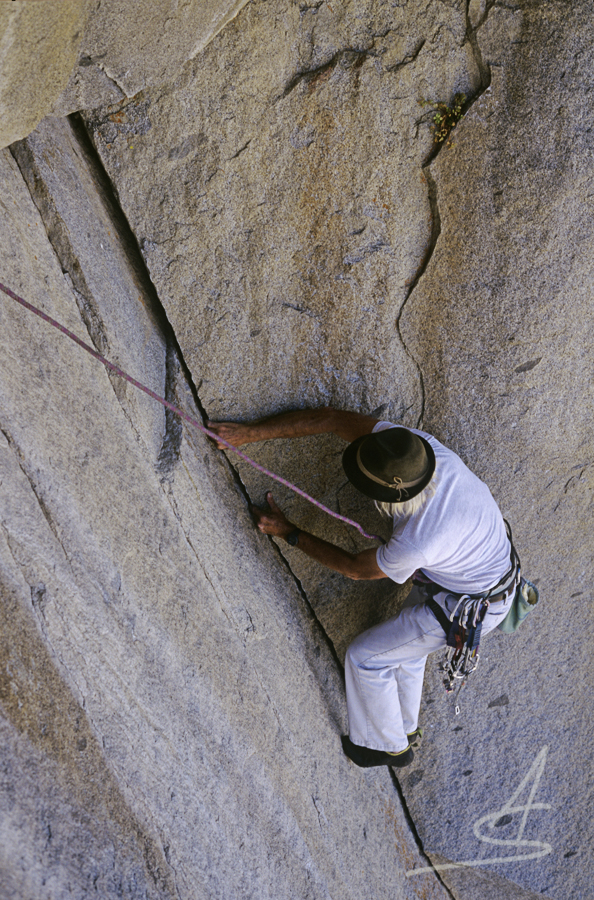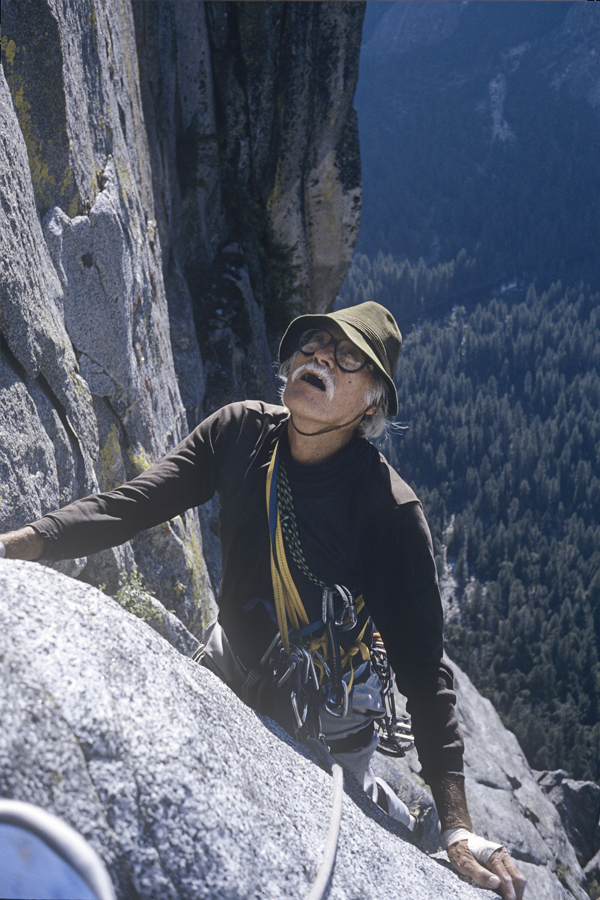Allen Steck passed away on February 23, he was 96. I was lucky to be his friend for some 25 years. We did a lot of climbing together, with me leading, back when he was 70+ years old and still ably following 5.9’s and 10a’s. He knew better than anyone I’ve known how to find quality and attainable challenge. Despite having a fine autobiography, published through Patagonia, I think relatively few people appreciate the depth and breadth of his career, for he stands as one of the greatest American climbers in history. Off the top of my head here is a summary, with added anecdotes and unchecked “facts” as I remember them.
Allen’s father was an active member of the Sierra Club, and passed on to Allen and brother George values for adventure and conservation, as well as an original copy of John Muir’s The Mountains of California, gifted and signed by Muir.
In the wake of WWII Allen went to college on the GI Bill in Switzerland, when Europe was in shambles. While there he answered a letter via the Club from a leading Austrian climber named Karl Lugmayer. The two spent the summer of 1949 climbing in Austria and the Dolomites, traveling from peak to peak on bicycles. Allen had brought from America one of the very first nylon climbing ropes (maybe the first?) to be deployed in Europe, and luckily so because on the Cima Grande an aid piton pulled and Karl took a 65-foot mostly airborne fall. The fall dinged Karl’s head pretty badly, but they were able struggle down to get it bandaged and go back and, with Allen’s lead, complete the climb the next day. He and Karl stayed in touch their whole lives, and a group of us met Karl when he flew over for Allen’s 80th birthday celebration in Berkeley.

Soon after Allen returned to California he pulled off some big climbs in 1950, difficult and demanding adventures that history seems to have lost in the bright lights that shined in Yosemite a few years later. His year included the first ascent of Castle Rock Spire, and then the oft-tried first ascent of the north face of Sentinel Rock, with John Salathé. After that he and a team of Sierra Club guys went deep into the BC Coast Mountains, where he readily led a new route up daunting Mt. Waddington, the rock-snow-ice king peak of the range. Then they toured around that area, arguably the most profoundly alpine territory south of the Yukon, and made a bunch of additional first peak ascents.
In 1953 he and Willi Unsoeld, Bill Long and Will Siri completed the first ascent of El Capitan’s east buttress, after a couple of attempts including one where they had to lower Bill Dunmire who took a bad aid fall and was fairly unconscious with a concussion.
Around 1952 Allen quit grad school and started working at The Ski Hut gear shop in Berkeley. As he became the store manager the shop became northern California’s hub for climbing gear and info. He then got into designing gear, making efficient, top-notch “Slimline” sleeping bags and I think tents too. During this decade he married, and raised daughter Sara and son Lee into outdoor adventure values.
In 1952 he went with other Sierrans to the big Cordillera Blanca to try some notable climbs. Unfortunately Oscar Cook got high altitude illness and died. After taking his body down to Lima the team returned, and Allen and Will Siri made a couple of big climbs, most notably an alpine-style first ascent of Huandoy East.
Over time he did quite a few other first ascents in the Sierra, including the wall of Angel Wings, the SE Face of Clyde Minaret, and the “Doors of Perception” route on N. Palisade.

Allen was also an avid skier, he often toured backcountry south of Tahoe. Sometime in the late ’40s (?) he and Dick Long and others skied from Mammoth Lakes, pushed through storms, and made the first winter ascent of Clyde Minaret. In the early ’60s while backcountry skiing near Echo Summit Allen was buried pretty deep in an avalanche. Friends heroically somehow located and dug him out in time. A few years later he teamed up with Lito Tejada-Flores to write Wilderness Skiing, which became America’s backcountry ski manual for awhile. During this period he went back up to BC with another Sierra Club group and led the first winter ascent of Mt. Waddington.
In 1954 Allen joined Will Siri and partners for America’s first Himalayan expedition after the war, hoping to climb Makalu by the futuristically huge southeast ridge. Teton guide Willi Unsoeld was on the team. The approach up the Arun Valley then was virtually unexplored and an ordeal in itself. Gradually they all realized they were overmatched on their first trip to super high altitude, on a route that would not be (and not quite) completed until 30 years later.
As Sara and Lee grew out of childhood dependency Allen restarted serious climbing. In 1963 he went with Dick Long and John Evans to the Tetons, and Long prompted them to try what a few had jokingly mused, traversing all the main Teton peaks, in a day. It took them their second try, but even as thunderstorms chased them they climbed Nez Perce, Cloudveil, South T, Middle T, Grand T, Owen and Teewinot, and returned to the car before dark.
In 1965 Allen and Dick Long were the lead force among six guys in making the incredible ascent of what hopefully is understood as the biggest route in the Western Hemisphere, the south “Hummingbird” ridge of Mt. Logan. Fred Beckey in 1994 told me how incredulous he was that “those California guys” would even try the thing. “We didn’t think they had a chance,” Fred said. This became one of the great success tales of mountaineering, and I heard Allen tell it around campfires a couple of times–how they persevered over a few thousand feet of steep walls with mediocre and bad rock and sloppy snow just to get to the wildly narrow crest of the ridge. Weeks in but still a long, long way to go, they got discouraged and voted whether to go on or to retreat. The deciding vote came to Jim Wilson, who asked Long, “Dick, can you get me off of this mountain?” Dick said “yes,” so they carried on. Soon after that they realized they were on “a forward retreat,” for to reverse their way back down would be such a convoluted epic that the best way to get home safely was to carry on over the top. Allen then told how the “Shovel Traverse” actually was not the nightmare it appeared. After a couple of ropelengths they realized the snow of July was fairly firm and sculptable, and the wild cornices and meringues and walls held their tightwire of cut steps and fixed ropes for repeated load carries pretty well. It was Dick who first went on lead with their drilled-out steel shovel and found that the crust was such that he could scoop out steps more readily than with an ice axe.
Allen was a very literate man. The shelves of his house in Berkeley were dense with all sorts of books, many, including the works of Goethe, in German. In 1967 he and Steve Roper talked David Brower and the Sierra Club into publishing a literary climbing annual, Ascent. Their determination to prod good writing out of not necessarily eloquent climbing writers made it the gold standard for climbing literature and the voice for thinking more deeply about climbing as art, style and challenge. I’m pretty sure Christian Beckwith would agree Ascent was an inspiration for starting Alpinist. Later, in the late ’70s Allen and Steve over no doubt a few sessions with wine decided that the classic way to show the under-appreciated grandeur of N. American climbing was to decide for themselves the most classic routes on the continent, and do a book featuring them. Part of the project was to climb as many of their recommendations as they could. Fifty Classic Climbs became the marquee book they imagined, and except in a couple of cases where climate change has transformed the peaks all the routes still stand up as characteristic testpieces.
In 1969 Allen and Leo LeBon started Mountain Travel, and Allen wrapped the Palisades School of Mountaineering under that umbrella. MT was America’s first real adventure travel company, and it played a large role enabling customers and guides, and partners and porters (especially in Nepal) to advance their lives through the delights and business of mountain adventuring.
In 1974 Allen was part of a large group of Americans invited by the USSR to climb peaks in the Pamirs. He, Chris Wren and Jock Glidden waited out a storm on Peak Lenin, and when they made their way to the top they came across the bodies of eight Russian women who had perished in the storm.
In 1976 Allen somehow was invited by climbers and the military in Pakistan to help them make the first ascent of Payu Peak. When I was in college I had a poster of Payu on my dorm wall–it was obviously not a peak but a fantasy, a surreal dream castle. But with Allen’s guidance the team climbed it, with Allen holding himself back not far from the top to leave the success to them. Young mountaineer Nazir Sabir went on from this, his “breakthrough” trip, to become Pakistan’s leading climber.
In 1983 Allen rejoined his brother George for another ultra-adventure, a walk, scramble, climb and occasional swim through the entire Grand Canyon, from Lee’s Ferry to Lake Mead. George was the Grand Canyon veteran and it sounds like Allen loved that expedition, 82 days long.

In 2000 Allen invited me to join him for what proved to be his last big climb, his fourth repeat of the Steck-Salathé route (he called it “The SS”) on Sentinel. It was appropriately too hot, on approximately the 50th anniversary of his FA. I’d never done the route before but with Allen aged 74 I was to lead it all. From the first pitch, even though I was competent at 5.11- I got worked. The rumors were right, that climb is way harder than the guidebook rating suggests. At various points he shared memories of where he and John huddled for the nights, and how at various impasses they’d searched left and right. It was astounding how tenacious they must have been—the route is justifiably infamous for long chimneys and wide cracks, and I thrutched and strained and struggled up those cracks, rationing a couple of big cams to keep the runouts just fairly scary–and those guys in 1950 had climbed with a simple bowline around their waists, lugged shoes, and no pitons wider than ¾ inch! It took them 4 ½ days. When Allen said they carried I think 4 quarts of water, I said, “Per day, per person, or?” “No, 4 quarts total!” He went on, “When we got to the top we were absolutely insane for water. John wandered off uphill looking for some delusional spring, and I headed down the gully. Eventually he crawled down and met me at the stream…” After our climb Allen took me out to dinner at the Lodge, and handed me one of those big cams. “Here, this is yours, I’ll never use it again…”
I visited Allen for the last time just a few weeks ago. He was spending his days comfortable in his chair at a side-building at his daughter Sara’s house, here in Bishop. He filled in some of the stories I knew. First, he told how his old friend Karl Lugmayer had told him his WWII story, right as Allen was boarding a ship at Genoa to come home. Karl relayed how he had been a reluctant member of the Werhmacht, recruited for his expertise with aeronautics and gliders. As the Germans’ war effort in early ’45 became desperate Karl was sent to the front lines near Flanders, to dig a foxhole. The weather was bad with poor visibility, and when Karl saw a British troop carrier come by he hopped into the back of it. The Brits drew their rifles but he delayed their fire by explaining in his excellent English he was surrendering. He finished the war as a POW.
Then Allen told me his own war story of that same year, how he was a deck hand on the USS George, a Destroyer escort. His main tale was of their mysterious non-deployment and the disaster of the USS Indianapolis. In 1945, unbeknownst to the crew, the Indianapolis delivered vital parts for assembling the A-Bombs to the island of Tinian. Right after that delivery the Navy sent the Indianapolis mysteriously unescorted to the Philippines, through lanes they knew were heavily patrolled by Japanese submarines. The Japanese sank the Indianapolis with torpedoes, and the Navy didn’t even have communications to know of it. Most of the 1200-man crew survived the sinking but no rescue came until after most of them had perished adrift, when they were found by a passing US aircraft. The Navy didn’t disclose the story until the day of the Japanese surrender. The ship’s Captain McVay survived but was scapegoated and court-martialed, but later reinstated and re-honored–years after he committed suicide.
Going through Allen’s long life of adventures, it’s obviously impressive how he was always “going for it,” his whole life. One night I glimpsed the youthful fire he must have had when he said, out of the blue, “My God, how could you look at the Hummingbird Ridge and not want to climb it?” Well, uh, some people might balk at it…He also told how he used to pull off this party trick, doing a pistol squat standing one-legged on a milk bottle. Yet I want to point out how, for all his “going-for-it,” year after year, in places and situations few or no one had ever been, he always kept sane and safe. When things got tough, and they did on essentially every one of his big climbs, he knew how to dig in and find more will and more effort, and more common-sense smarts to stay alive and safe. Right through all of his last climbing years he was pushing himself with sound judgement.
In the same half hour that his son Lee sent me the message about his passing, I saw a post that a big rockfall had peeled off of El Capitan, just left of the East Buttress route he did with Willi Unsoeld back in 1953. These two stories seem like connected, parallel news.
© 2023 by Andy Selters

